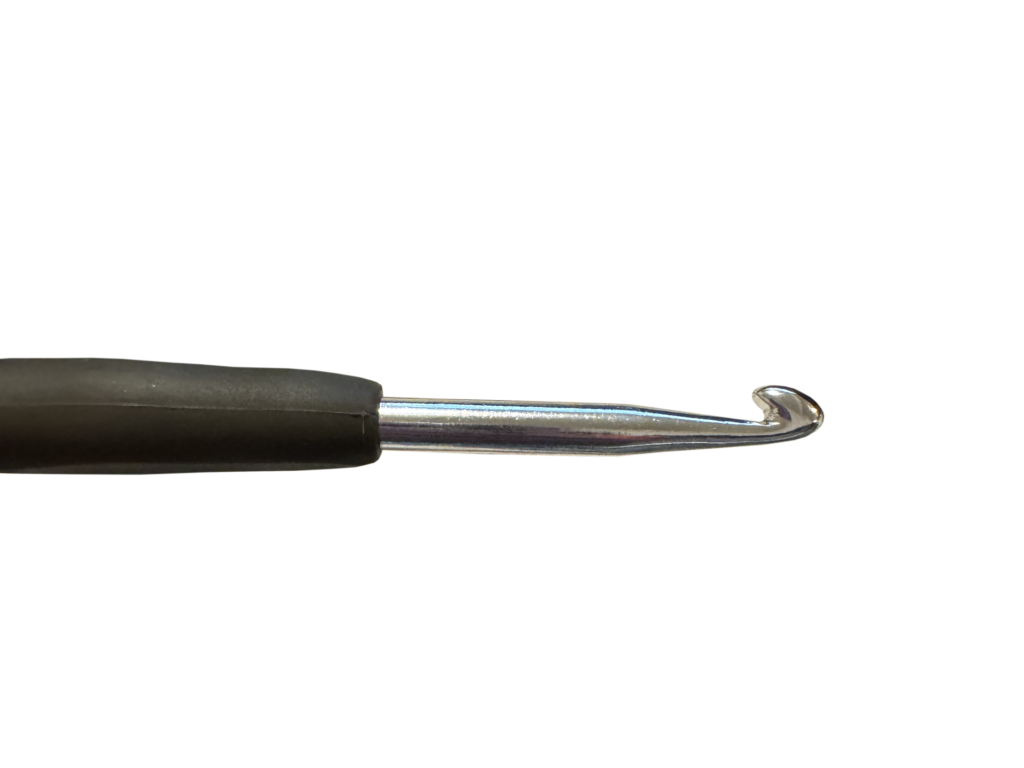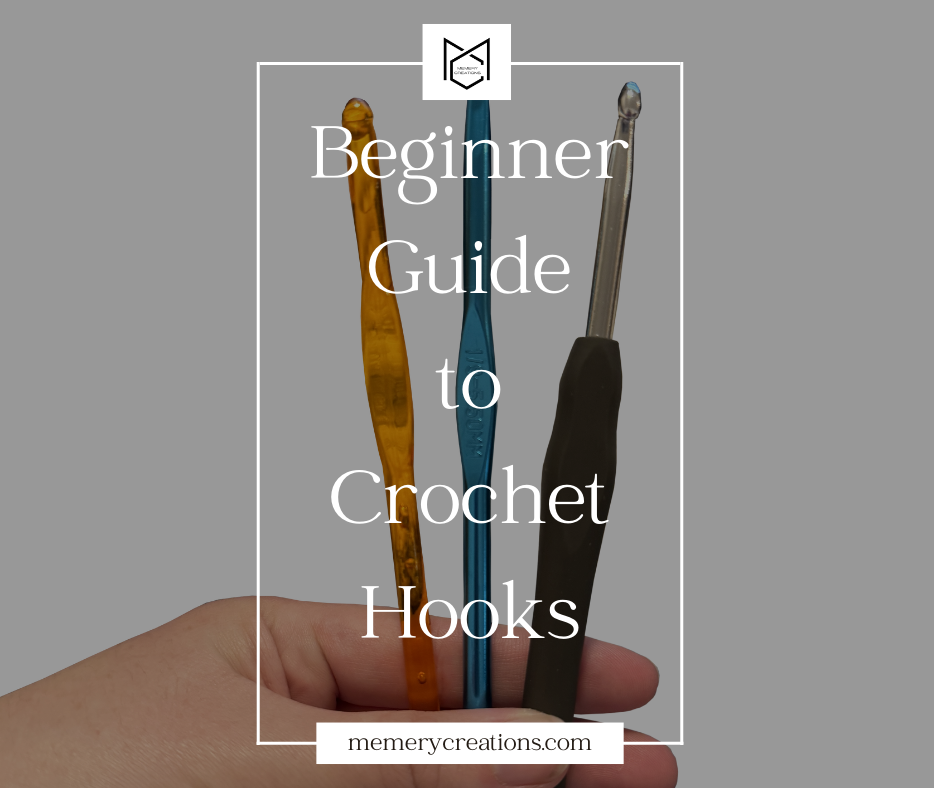This post contains affiliate links from Amazon. If you make a purchase through these links, I may earn a commission at no additional cost to you. Thank you for supporting my blog! #ad
So you decided to dive into the world of crochet, welcome! Crochet can sometimes seem daunting and intimidating, but don’t worry, I’m here to help break it down for you! I’m Marissa, and my mom first taught me to crochet when I was a young girl. Over the years I have honed in on my craft, and now want to share my crochet knowledge and journey with you! Let’s dive in and talk about different types of crochet hooks.
On the surface, most crochet hooks look similar. They are a small device with an open hook on the end to help its user create beautiful masterpieces with yarn or thread. Diving deeper, there are several different types of hooks that you can use in your crochet journey. What you choose is entirely your preference and there isn’t necessarily a “right” or “wrong” hook type for your project. Today, we will talk about the different hook and handle shapes, materials, and sizes.
Inline vs. Tapered
Many people just starting out with crochet won’t notice or realize that there are different head shapes to crochet hooks, inline and tapered. When you are just learning how to crochet, the shape won’t matter too much. As you get more comfortable with the yarn and the hook, you may want to experiment with different hook shapes to find the one that suits you best. Some crocheters prefer inline hooks while others prefer tapered. So, what’s the difference?
Inline Hooks are completely flat through the entire length of the tool. The inside crook of the hook itself will typically have a “cut out” appearance, allowing the yarn to almost get caught in the hook. Crocheters that prefer this style of hook say the inline hook holds their yarn better and allows them to multi-task without worrying about the yarn falling off the hook. Crocheters that do not like this style hook claim that the sharp cut out splits or snags their yarn.
Tapered hooks typically have a slightly raised hook head, with a thinner neck and shaft. The inside crook of the hook does not have as harsh of cut out than the inline hook. Crocheters that prefer this style of hook say the tapered hook gives them better tension control. Crocheters that do not like this style hook claim that the yarn slides off too easily.

Which one is better? It really comes down to preference. On both sides, people claim that their preferred hook head gives them better tension control, it holds the yarn better, and is easier to work with. Another factor to consider is how the crochet hook itself is held, as there are several different ways to hold a crochet hook. The best recommendation would be to try both styles and see which one works the best for you.
Crochet Hook Materials
Crochet hooks can come in a variety of different materials, and all with different price points. Plastic hooks tend to be on the less expensive side, while metal, ergonomic hooks can get fairly pricey. Like the hook head shape, each person has their own preference for hook material. Let’s take a look at a few different materials.
Plastic hooks are very common for beginner crocheters. Their low cost makes them easier to acquire and learn on.
These Boye Crochet Hooks are a popular choice for beginner crocheters. They come in the most popular sizes, feature a tapered head, and are very cost effective for those on a budget.
Also, these Susan Bates Crochet Hooks are a great choice for beginner crocheters, and this is the set I bought when I got back into crocheting as an adult. They come in the most popular sizes, they feature an inline head and got me right back up to speed with where I left off in my crochet journey.

The biggest issues that people find when they use plastic crochet hooks are that certain yarns like acrylic do not slide easily against the plastic shaft, which can disrupt the flow of a crocheter in their groove. Another common problem people face with plastic crochet hooks is that they are the most easy hooks to break. Several crocheters have reported snapping their plastic hooks and having to purchase new ones. Keeping a set of plastic hooks handy is always a good idea, as they are the most easy hook to travel with on airlines.
Wood or bamboo is another popular type of crochet hook. Users of wooden crochet hooks like the flexibility that they have, while still being strong enough for tight crocheting. The lightweight material also ensures the crocheter has less fatigue and strain on their hands and wrists.
This set of bamboo crochet hooks from Hestya come in many different sizes, ranging from very small to very large. They have great reviews and are fairly affordable, featuring an inline hook head.
If you want to get super fancy, many special artists handcraft wooden crochet hooks. You can typically find these treasures on sites like Etsy, but be ready to pay a premium, as most of these hooks are made by hand.
Naturally, one of the biggest downsides to using wooden hooks is that lower quality or old hooks may begin to splinter or dry out. Additionally, while they provide more flexibility than plastic hooks, they can still break if too much pressure is applied.
Metal hooks are some of the most common crochet hooks used by hobbyists. The price of these hooks can range from very affordable to more expensive. Many crocheters opt for metal hook heads with a different shaft type, whether its plastic, silicone, or some other sort of soft material. You can, of course, purchase bare metal hooks.
These Boye metal crochet hooks were actually the very next set I purchased after the plastic set I bought. These hooks come in most of the popular sizes, feature a tapered head, and are affordable.
If you’re looking for a metal crochet hook with an inline head, check out these Susan Bates metal crochet hooks. They are still affordable and come in the most popular sizes.

Metal hooks allow the yarn to easily slide up and down the crochet hook with ease. In fact, it may take some getting used to if you switch directly from a plastic hook to a metal hook. But trust me, once you go to a metal hook, you won’t want to go back!
The biggest drawback to bare metal hooks is that the smaller the hook, the smaller the shaft. When working with smaller hooks, the thin shaft can cause a lot of fatigue for crocheters. They often find their their fingers and hands get tired quicker because they are using so much energy to hold the thin diameter of the crochet hook. Another drawback to using bare metal crochet hooks is that they can get cold very fast which is no fun for anyone, especially in the colder months.
As stated earlier, some crocheters opt for a metal hook head with a different material shaft. Please welcome to the stage, ergonomic hooks. Ergonomic hooks couple the brilliance of a metal hook with a typically larger, easier to hold shaft. The shaft can be made of different materials and crocheters all have their own preferences.
Low cost ergonomic hooks (the ones I bought!): Yarniss ergonomic crochet hooks
Higher cost ergonomic hooks: Clover Amour crochet hooks
Bamboo/metal ergonomic hooks: Coopay bamboo crochet hooks
Ergonomic hooks allow crocheters to work on a project for hours without the fatigue that the previous hook types cause. I have personally been able to work up to 6 hours straight with the use of an ergonomic hook. There are a couple downsides, however. The first is that you are limited to your shaft length. If you are working on a project that requires you to have many loops on your hook, you may find yourself running out of room. Different companies sell different shaft lengths, so make sure you find one that fits your needs. Another downside is that some people have broken their hooks at the connection point between the metal and handle, which is something you wouldn’t typically see on a bare metal crochet hook.

I’ll touch on interchangeable hooks just for a bit here. Some crocheters like the convenience of having a single handle and simply changing out the crochet head for whichever size they need. These come in a wide variety of styles, with plastic, wood, or metal interchangeable hooks. Some hooks can even light up! I have personally never used an interchangeable hook set so I don’t have much to say about their ease of use, but many people do like them for the convenience factor.
There is no clear winner for material type. Just like with head shape, the material of crochet hook you choose is up to your preference and your crochet style. Choose a material that feels good in your hands, and feel free to buy multiple different kinds until you find your match.
Hook Sizes
Lastly, let’s talk about hook sizes. Depending who you talk to and where you live, people may refer to different naming conventions when talking about their crochet hook sizes. It really doesn’t matter which you prefer, but just know that sometimes the naming conventions are not the same across all brands.
In the U.S., it is typically to see a letter/number naming convention. You may see this as I/9 or G/6 on the crochet hook itself. Normally, the closer the letter is to “A”, the smaller the hook. So a “J” hook will be larger than a “F” hook, but smaller than an “M” hook. However, I have seen first-hand that different brands may have different letters assigned to different sized hooks, so just be aware of that if using this naming convention.
Another way crocheters differentiate sizes by the millimeter (mm) sizing. This is a much more standardized way to differentiate between sizes, leaving less confusion. The most common sizes for crochet hooks are 4mm, 5mm, and 5.5mm. Crochet hooks can either be in .25, .5, 75., or single digit increments. (3.75mm, 4.25mm, 5.5mm, 6mm). Using this naming convention is more universal, but you may see some crocheters still refer to their hook size by their letter/number.
My mother still refers to her hook by its letter/number, while I opt for the mm sizing. In general, the mm sizing will be the most accurate, but for the most part, the letter/number naming convention will give you a good idea of what size hook to start with. Most crochet hooks will have both naming conventions on them anyway.
Many patterns will list a suggested hook size, and in my personal experience, 99% of the time they use the mm sizing, but I have seen a few patterns referencing the letter/number sizing. Most yarns will also list a suggested hook size on the label itself, but that is just a suggestion and does not mean you must use that hook size to use that yarn.
Conclusion
Believe it or not, I have only just scratched the surface of different crochet hooks. There are even more types of hooks to discover, but that can wait until you’re more familiar with crocheting and ready to kick it up a notch! You can probably start to see that there are no definitive answers in the crochet community about what is the best in its category. Every person is so unique so what works for them may not work for you. Experiment and try different hook types to see which one makes you feel comfortable and will help you along on your crochet journey.


